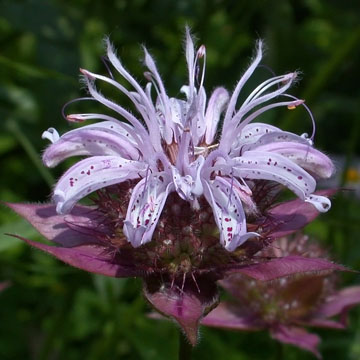

Monarda bradburiana - (image 1 of 5)
Taxonomy
Family: Lamiaceae
Synonymous with Monarda russeliana Nutt.
Habitat
Rocky upland woods, thickets, openings, and bluffs.
Associates
Distribution
Southern IN to IA and eastern KS, south to southern AL and TX.
Morphology
Herbaceous perennial; stems 30-60 cm, usually simple, glabrous or sparsely villous; leaves sessile or subsessile, ovate or deltoid-ovate to lance-deltoid, acuminate, serrate, rounded or subcordate at the base, sparsely hairy above, villous on the veins beneath; bracteal leaves often tinged with pink or purple, spreading or reflexed, lanceolate; calyx hirsute in the throat, its lobes subulate, often stipitate-glandular; corolla pale rose-purple to white, dotted with purple, 2.5-3.5 cm, the upper lip slender, nearly straight, about as long as the tube.
Notes
Flowers May to June
Wetland indicator: NA
Flowers earlier than M. didyma and M. fistulosa which both have distinct petioles usually well over 5 mm long.
References
Gleason, Henry A. and A. Cronquist. 1991. Manual of Vascular Plants of
Northeastern United States
and Adjacent Canada. Second Ed.
The New York Botanical Garden. Bronx, NY
|
Michael Hough © 2018 |